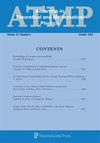Holographic space-time, Newton’s law, and the dynamics of horizons
IF 1
4区 物理与天体物理
Q3 PHYSICS, MATHEMATICAL
Advances in Theoretical and Mathematical Physics
Pub Date : 2020-03-07
DOI:10.4310/atmp.2023.v27.n1.a3
引用次数: 19
Abstract
We revisit the construction of models of quantum gravity in d dimensional Minkowski space in terms of random tensor models, and correct some mistakes in our previous treatment of the subject. We find a large class of models in which the large impact parameter scattering scales with energy and impact parameter like Newton`s law. The scattering amplitudes in these models describe scattering of jets of particles, and also include amplitudes for the production of highly meta-stable states with all the parametric properties of black holes. These models have emergent energy, momentum and angular conservation laws, despite being based on time dependent Hamiltonians. The scattering amplitudes in which no intermediate black holes are produced have a time-ordered Feynman diagram space-time structure: local interaction vertices connected by propagation of free particles (really Sterman-Weinberg jets of particles). However, there are also amplitudes where jets collide to form large meta-stable objects, with all the scaling properties of black holes: energy, entropy and temperature, as well as the characteristic time scale for the decay of perturbations. We generalize the conjecture of Sekino and Susskind, to claim that all of these models are fast scramblers. The rationale for this claim is that the interactions are invariant under fuzzy subgroups of the group of volume preserving diffeomorphisms, so that they are highly non-local on the holographic screen. We review how this formalism resolves the Firewall Paradox.全息时空,牛顿定律,视界动力学
我们用随机张量模型重新讨论了d维闵可夫斯基空间中量子引力模型的构造,并纠正了我们以前处理这个问题时的一些错误。我们发现了一大类模型,在这些模型中,大的冲击参数散射与能量和冲击参数具有类似牛顿定律的尺度关系。这些模型中的散射振幅描述了粒子喷流的散射,也包括了产生具有黑洞所有参数特性的高亚稳定态的振幅。这些模型有涌现的能量、动量和角守恒定律,尽管它们是基于与时间相关的哈密顿量。不产生中间黑洞的散射振幅具有时间顺序的费曼图时空结构:由自由粒子传播连接的局部相互作用顶点(实际上是Sterman-Weinberg粒子射流)。然而,射流碰撞形成大型亚稳定物体的振幅也存在,这些物体具有黑洞的所有缩放特性:能量、熵和温度,以及扰动衰减的特征时间尺度。我们推广了Sekino和Susskind的猜想,证明所有这些模型都是快速扰频器。这种说法的基本原理是,相互作用在保持体积的微分同态群的模糊子群下是不变的,因此它们在全息屏幕上是高度非局部的。我们将回顾这种形式主义是如何解决防火墙悖论的。
本文章由计算机程序翻译,如有差异,请以英文原文为准。
求助全文
约1分钟内获得全文
求助全文
来源期刊

Advances in Theoretical and Mathematical Physics
物理-物理:粒子与场物理
CiteScore
2.20
自引率
6.70%
发文量
0
审稿时长
>12 weeks
期刊介绍:
Advances in Theoretical and Mathematical Physics is a bimonthly publication of the International Press, publishing papers on all areas in which theoretical physics and mathematics interact with each other.
 求助内容:
求助内容: 应助结果提醒方式:
应助结果提醒方式:


